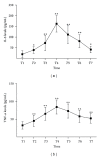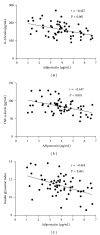Relationships of adiponectin with markers of systemic inflammation and insulin resistance in infants undergoing open cardiac surgery
- PMID: 23840093
- PMCID: PMC3691928
- DOI: 10.1155/2013/187940
Relationships of adiponectin with markers of systemic inflammation and insulin resistance in infants undergoing open cardiac surgery
Abstract
Background: Insulin resistance and systemic inflammation frequently occur in infants undergoing cardiac surgery with cardiopulmonary bypass, while adiponectin has been demonstrated to have insulin-sensitizing and anti-inflammatory properties in obesity and type 2 diabetes mellitus. In this prospective study, we aimed to investigate the association of adiponectin with insulin resistance and inflammatory mediators in infants undergoing cardiac surgery with cardiopulmonary bypass.
Methods and results: From sixty infants undergoing open cardiac surgery, blood samples were taken before anesthesia, at the initiation of cardiopulmonary bypass and at 0, 6, 12, 24, and 48 hours after the termination of cardiopulmonary bypass. Plasma interleukin-6 (IL-6), tumor necrosis factor-alpha (TNF- α ), and adiponectin levels were assessed in blood samples. Insulin resistance was measured by assessment of the insulin requirement to maintain euglycaemia and repeated measurements of an insulin glycaemic index. Insulin glycaemic index, IL-6, and TNF- α increased up to 3-8-fold 6 h after the operation. Adiponectin is negatively correlated with markers of systemic inflammation 6 h after CPB.
Conclusions: Although the level of serum adiponectin decreased significantly, there was a significant inverse association of adiponectin with markers of systemic inflammation and insulin resistance in infants undergoing open cardiac surgery.
Figures




References
-
- Butler SO, Btaiche IF, Alaniz C. Relationship between hyperglycemia and infection in critically ill patients. Pharmacotherapy. 2005;25(7):963–976. - PubMed
-
- Vanhorebeek I, Langouche L, van den Berghe G. Glycemic and nonglycemic effects of insulin: how do they contribute to a better outcome of critical illness? Current Opinion in Critical Care. 2005;11(4):304–311. - PubMed
-
- van den Berghe G, Wouters P, Weekers F, et al. Intensive insulin therapy in critically ill patients. The New England Journal of Medicine. 2001;345(19):1359–1367. - PubMed
-
- van den Berghe G, Wilmer A, Hermans G, et al. Intensive insulin therapy in the medical ICU. The New England Journal of Medicine. 2006;354(5):449–461. - PubMed
-
- Zheng R, Gu C, Wang Y, et al. Impacts of intensive insulin therapy in patients undergoing heart valve replacement. Heart Surgery Forum. 2010;13(5):E292–E298. - PubMed
Publication types
MeSH terms
Substances
LinkOut - more resources
Full Text Sources
Other Literature Sources

